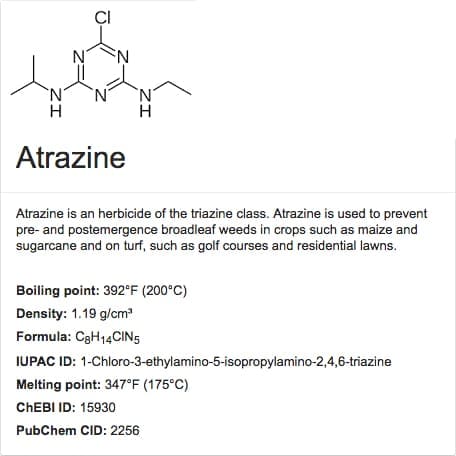Atrazine water filter
What is Atrazine?
Atrazine is an organic compound, a chlorinated herbicide, and one of the most popular herbicides in the U.S.
This chemical has been banned in other parts of the world, including in the European Union, due to contamination of the drinking water supply and a negative environmental health hazard assessment.
What is Atrazine Used For?
Atrazine is a widely used herbicide that is applied to crop fields in order to control weeds. This chemical is not only crucial in agriculture but is also used in other outdoor spaces like golf courses and residential lawns.
While this chemical is effective at killing weeds, it is not safe for human consumption, even in small doses. Like other herbicides, it can cause an increased risk of health defects if it contaminates drinking water.
How Does Atrazine Get In Drinking Water?
Like other herbicides, the chemical atrazine seeps into groundwater where it has been used on agricultural fields, grass, and crops as a pesticide. This is otherwise known as agricultural runoff. From there, the chemical can be absorbed into the drinking water supply.
The compound has been known to contaminate drinking water in drinking water wells too. This happens when atrazine seeps into groundwater. These wells are particularly vulnerable because they are unregulated by the EPA, so owners need to be diligent in testing their water for atrazine contamination as well as other herbicides.
Health Effects of Atrazine Contamination in Water
Atrazine can have a number of adverse health impacts when it contaminates drinking water. Though these outcomes may sound scary, it’s important to remember that they may only occur after long-term consumption of atrazine at high levels.
The chemical can cause congestion of the heart, lungs, and kidneys. The chemicals present in this compound can act as a hormone disruptor. As a result, victims may experience low blood pressure, muscle spasms, weight loss, damage to adrenal glands, cardiovascular damage, retinal degeneration, muscle degeneration, and increased cancer risk.
The types of cancer linked to this chemical include breast cancer, ovarian cancer, and uterine cancer. Blood cancer — otherwise known as leukemia — and lymphoma are also risks.
Finally, there are several risks to the reproductive system, including birth defects, hormonal irregularities, and altered menstrual cycles. This evidence was collected after a series of epidemiological studies on female and male frogs.
What is the Environmental Protection Agency (EPA) Standard for Atrazine?
The federal government places restrictions on how atrazine can be used to protect water sources.
In a recent proposal, the agency suggested prohibiting the application of this compound when soils can retain water or during storm events, prohibiting aerial applications of atrazine, and restricting use to 2 pounds or less per acre per year.
The agency periodically changes its restrictions on this herbicide by continually monitoring its impact on drinking water.
How Do You Remove Atrazine From Tap Water?
You can achieve almost full atrazine removal from your drinking water with a granular activated carbon filter.
Removing atrazine from your drinking water should be a priority for you and your family. Need a water filter that will remove this compound? Check out our line of whole-house water filters.
Whole-house water filters are easy to maintain, highly effective, and a great way to remove many contaminants from your water. In addition to atrazine, you can reduce higher-than-normal concentrations of chlorine, PFOS, PFAS, and heavy metals.
Keep in mind that higher-than-usual atrazine concentrations do not just have negative health effects when consumed in drinking water. This compound can also seep into the skin when bathing and showering. Since it is an herbicide, it can also harm plants (and pets) if they’re fed a steady diet of water with high atrazine concentrations.
From The Agency of Toxic Substances and Disease Registry
Atrazine is the common name for an herbicide that is widely used to kill weeds. It is used mostly on farms. Pure atrazine-an odorless, white powder-is not very volatile, reactive, or flammable. It will dissolve in water. Atrazine is made in the laboratory and does not occur naturally.
Atrazine is used on crops such as sugarcane, corn, pineapples, sorghum, and macadamia nuts, on evergreen tree farms, and for evergreen forest regrowth. It has also been used to keep weeds from growing on both highway and railroad rights-of-way. Atrazine can be sprayed on croplands before crops start growing and after they have emerged from the soil. Some of the trade names of atrazine are Aatrex®, Aatram®, Atratol®, and Gesaprim®. The scientific name for atrazine is 6-chloro-N-ethyl-N’-(1-methylethyl)-triazine-2,4-diamine. Atrazine is a Restricted Use Pesticide (RUP), which means that only certified herbicide users may purchase or use atrazine.
Certification for the use of atrazine during the growing season is obtained through the appropriate state office where the herbicide user is licensed.
Certified herbicide workers (see Section 1.7) may spread atrazine on crops or croplands as a powder, liquid, or in a granular form. Atrazine is usually used in the spring and summer months. For it to be active, atrazine needs to dissolve in water and enter the plants through their roots. It then acts in the shoots and leaves of the weed to stop photosynthesis. Atrazine is taken up by all plants, but in plants not affected by atrazine, it is broken down before it can have an effect on photosynthesis. The application of atrazine to crops as an herbicide accounts for almost all of the atrazine that enters the environment, but some may be released from manufacturing, formulation, transport, and disposal.
Complete information about the sources, properties, and uses of atrazine can be found in Chapters 4 and 5 of this profile.
For more information, contact:Agency for Toxic Substances and Disease RegistryDivision of Toxicology and Human Health Sciences1600 Clifton Road NE, Mailstop F-57Atlanta, GA 30333Phone: 1-800-CDC-INFO · 888-232-6348 (TTY)Email: contact CDC-INFO
ATSDR can also tell you the location of occupational and environmental health clinics. These clinics specialize in recognizing, evaluating, and treating illnesses resulting from exposure to hazardous substances.


